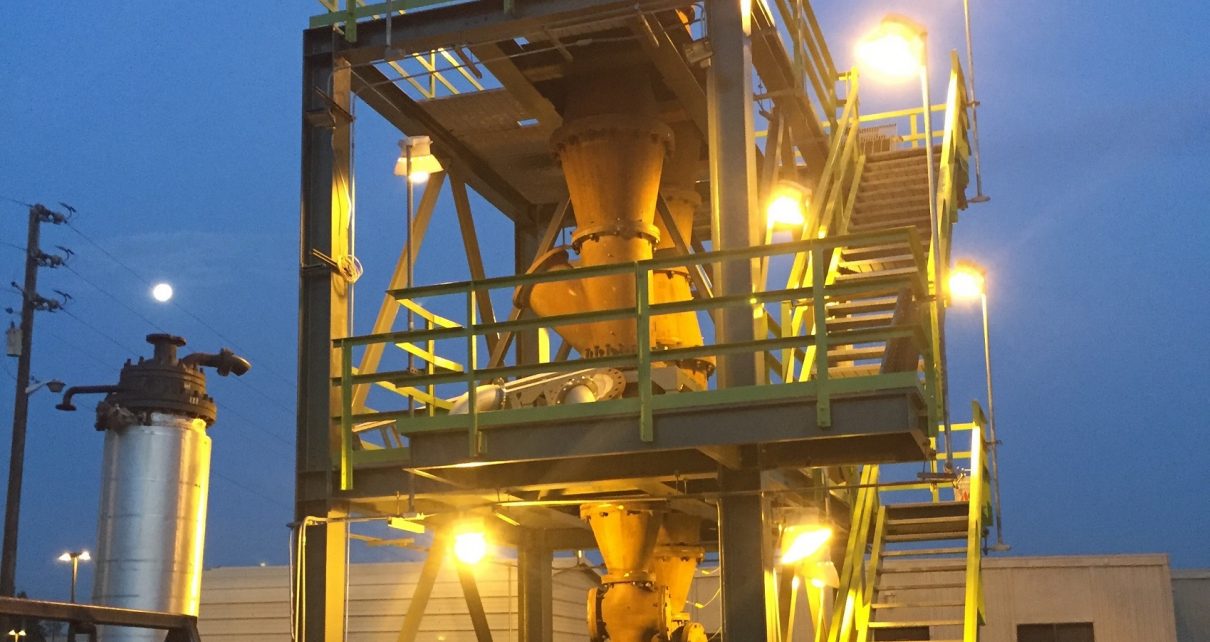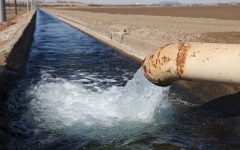
Natural gas production. (Photo: ucr.edu)
Ringside: The Numbers Driving California vs. Washington on Energy, Water & Forestry
California was once home to six nuclear power plants, generating over 50,000 gigawatt-hours per year
By Edward Ring, November 21, 2024 3:30 am
 With national election results that have delivered a surprisingly unequivocal result, California’s business interests now find themselves on a political tightrope. On one side, the incoming Trump administration will pursue deregulation that may help businesses remain in California, and on the other side, the Newsom administration is going to do everything in its power to stop them. For many businesses in California, successfully balancing these powerful competing forces is a matter of survival.
With national election results that have delivered a surprisingly unequivocal result, California’s business interests now find themselves on a political tightrope. On one side, the incoming Trump administration will pursue deregulation that may help businesses remain in California, and on the other side, the Newsom administration is going to do everything in its power to stop them. For many businesses in California, successfully balancing these powerful competing forces is a matter of survival.
Rather than offer a rhetoric-heavy dive into the politics of Trump vs. Newsom, we shall present some numbers-based arguments in an attempt to explain how California’s current regulatory environment puts unrealistic expectations on industry, and sets unrealistic environmental goals that in many cases are unhelpful or even counterproductive. Whether or not the Trump cure is worse than the Newsom disease is for others to ponder. Here are some facts:
1 – To achieve net-zero, the California Air Resources Board has set a goal to produce 500,000 gigawatt-hours of electricity per year by 2045, up from current consumption of roughly 215,000 gigawatt-hours generated in-state plus another 65,000 gigawatt-hours of imported electricity. Natural gas generated power is responsible for 44 percent of California’s in-state electricity generation. Shutting down natural gas power plants while simultaneously more than doubling electricity production in 20 years is nearly impossible, and also prevents California from participating in spectacular innovations that may enable efficiency of natural gas combined cycle power plants to exceed 70 percent.
2 – The state proposes installing 25 gigawatts of offshore wind capacity, which would deliver an estimated 85,000 gigawatt-hours per year to the grid. This would require 2,500 floating 10 megawatt wind turbines 20 miles offshore, each one about 1,000 feet tall, anchored in water 4,000 feet deep, with high voltage undersea transmission lines connecting each of them to land-based substations. If these monstrosities are ever built, the total project cost will easily exceed $300 billion, with catastrophic consequences to the marine environment including migrating whales.
3 – In response to wildfires, in 2020 Governor Newsom announced California will ban sales of new gasoline powered vehicles by 2035. This freezes out advanced hybrid cars from having any chance to compete for market share and ignores the fact that EV sales growth is leveling out at only 5 percent of all vehicles in California.
4 – In further pursuit of net-zero, CARB has just adopted a new lower carbon fuel standard, something that will increase California’s already nation-leading price per gallon of gasoline by “$0.65 in the near term and nearly $1.50 by 2035.” But low carbon feedstock, which is mostly imported into California, is already maxed. To replace gasoline in California with corn ethanol, for example, would require over 60,000 square miles of cornfields, consuming well over 100 million acre feet of irrigation water per crop. Similar biofuel oriented fuel solutions are equally unsustainable.
5 – Despite decades of effort and billions in subsidies, Californians still get 50 percent of their energy from petroleum. And despite reserves of crude oil estimated at more than 27 billion barrels, California imports 75 percent of its oil. Field production in California has dropped from 400 million barrels per year in the 1980s to only 118 billion barrels in 2023. Relentless tightening of regulations has brought the industry to a tipping point. California is losing its capacity to drill and extract oil, even though oil consumption in the state is actually up over the past three years.
6 – Policies that end oil production in California may only drive up imports from nations that lack California’s environmental standards or labor protections, but state policies attacking our refineries will cause a crisis. California’s gasoline formulation is unique, and only California refineries can produce it. But two days after the legislature passed a law imposing expensive new inventory storage and reporting requirements on the state’s refineries, Philips 66 announced – while insisting the timing was a coincidence – that they will close their refinery in Los Angeles. California’s refinery capacity is 1.62 million barrels per day, against consumption of 1.45 million barrels per day. That’s a 10.7 percent surplus. When the Phillips 66 plant closes next year, refinery capacity will drop to 1.48 million barrels per day, dropping surplus capacity to only 2.3 percent. One blip, and we’ll have gas lines that make 1979 look like a cakewalk.
7 – California’s water policies for the last 20 years have rested on one inviolable premise. The more “unimpaired flow” we release to the rivers, the better our chances to save salmon and other threatened aquatic species. But it isn’t working. The focus on flow has become an excuse to delay or diminish implementation of harder solutions: upgrading wastewater treatment, controlling introduced predators such as bass, restoring habitat, and expanding more innovative hatchery programs. Meanwhile, California’s households are about to have indoor water rationed down to 42 gallons per person per day, and up to a million acres of the best irrigated farmland on earth is about to be taken out of production.
8 – If the fruits of water rationing are water starved households and fallow farmland, the solution – build more water supply infrastructure – is all but impossible. Whether it’s new off-stream reservoirs, desalination, or even the politically favored solutions of aquifer recharge, runoff harvesting, and wastewater recycling, nothing happens fast, if it happens at all. Since 1970, Californians have only constructed one major reservoir, and there is still only one large scale desalination plant in a state with over 800 miles of shore and 25 million people living in coastal counties. There are projects that could safely harvest millions of acre feet from the Sacramento-San Joaquin Delta during winter storms, solving water scarcity in California forever. Will they ever get built?
9 – While California summers may be hotter and dryer in recent years, that isn’t the primary reason our forests are stressed and burning. Thanks to a century of increasingly effective wildfire suppression combined with a timber industry nearly regulated out of existence, California’s trees now have 5 to 10 times more than a historically normal density. They’re competing for an insufficient share of light, water and nutrients, leading to disease, infestations, dehydration and death. Up through the 1980s California harvested 6 billion board feet per year of timber; the annual harvest is now 25 percent of that. We have turned our forests into tinderboxes, and that is the reason fires turn into superfires. Reviving the timber industry and reviving controlled burns is the solution. Done responsibly, there is even evidence this will actually help wildlife including endangered species.
10 – California was once home to six nuclear power plants, generating over 50,000 gigawatt-hours per year. But San Onofre, which might have been retrofit, took its 2.6 gigawatt output offline in 2012. The other big plant was Rancho Seco in the Sacramento Valley, generating 913 megawatts until it was taken offline in 1989. Now, instead of building nuclear power plants with modern designs, California’s last operating reactors at Diablo Canyon are one regulatory hiccough away from permanent shutdown. Why? Taking total system cost into account, nuclear power generation is less expensive than most renewables. New advances in nuclear power technology promise large and small scale generating solutions that are safe and cost effective.
When considering each of these ten areas – natural gas, offshore wind, EVs, biofuel, oil drilling, oil refining, water rationing, water supply projects, forestry, and nuclear power – business leaders in California have to honestly ask themselves a tough question: Which administration is more likely to promote policies that are good for the economy, good for business, good for jobs, good for controlling the cost-of-living, and even best for the environment? Is it going to be the administration in Washington DC, or the administration in Sacramento?
Contrary to our governor’s dire proclamations, not everything coming out of Washington is going to be harmful to our state, its economy, or its people. To the extent businesses in California embrace some of the productive policies that come out of Washington DC, they should not fear retaliation from Sacramento. But that’s the tightrope they’re walking right now, and it should not have to be that way.
- Ringside: EVs and California’s Future Demand for Electricity - December 4, 2025
- Ringside: Politically Viable Water Supply Projects - November 27, 2025
- Ringside: Shifting Costs Does Not Solve California’s Electricity Shortages - November 20, 2025





“Field production in California has dropped from 400 million barrels per year in the 1980s to only 118 billion barrels in 2023.”
Don’t you mean 118 million, not 118 billion barrels?
As a little boy, I once had a goal to collect 1,000 bottle caps. Finally, I met my goal.
Nothing changed.
Just hope Diablo Canyon keeps humming along, that is the next target for the Whacko’s
Outstanding, well-researched article. The utter hypocrisy and lack of common sense in Sacramento is staggering.
The best chance for Republicans isn’t along ideological issues – it is to hammer Dems on their gross incompetence in managing the state, with energy and water at the forefront.
In 1990 the legislature passed the spotted owl bill that shut down the forest industry. The results were no more logging and thus no forest management. Because of this, our forests have become overgrown and the resulting fires have been devastating, destroying billions of dollars worth of homes and displacing thousands of families. I wonder how many animals have been killed in these fires, all to save the spotted owl. It is not climate change it is poor leadership.
Now the goobermint wants to actively kill other owls that they claim compete with spotted owls. Anything that promotes death the Dems are all in on.